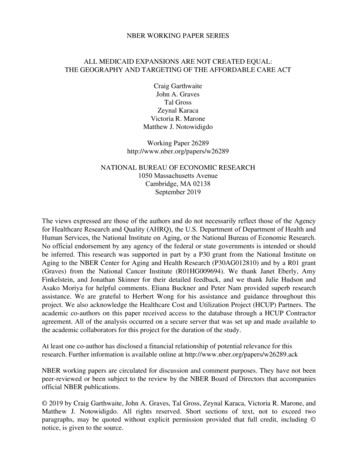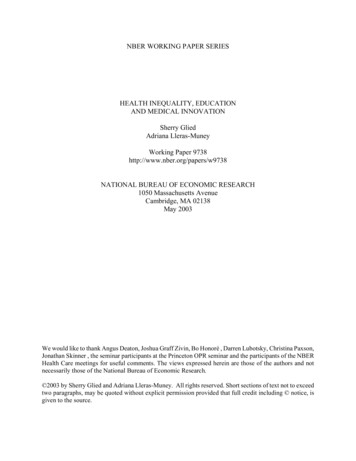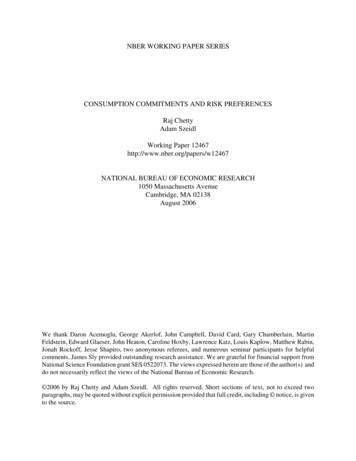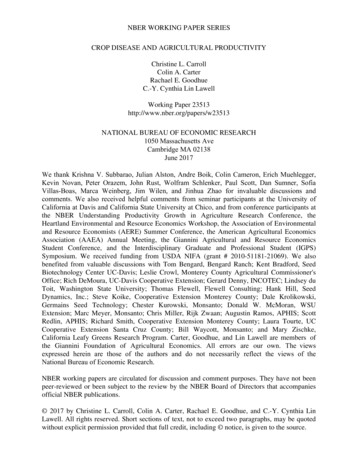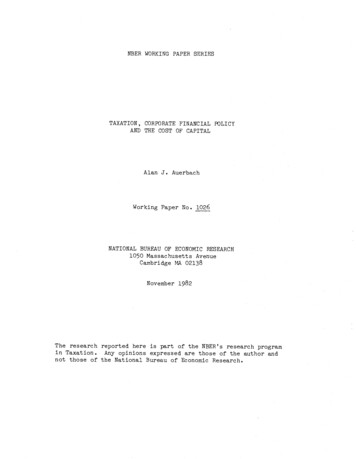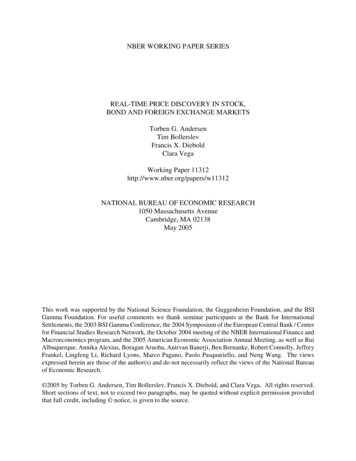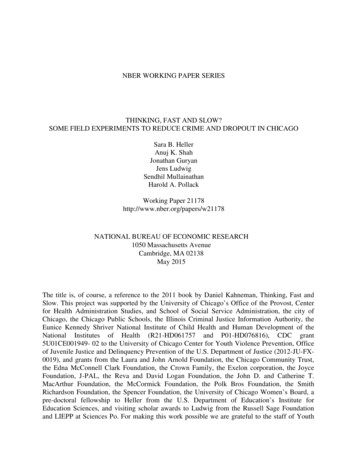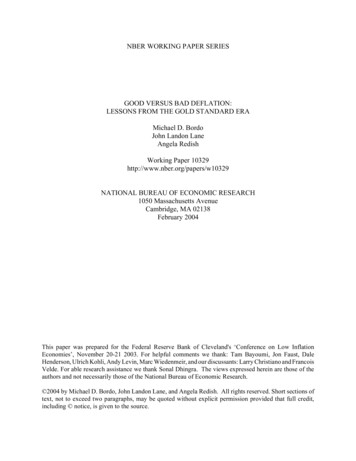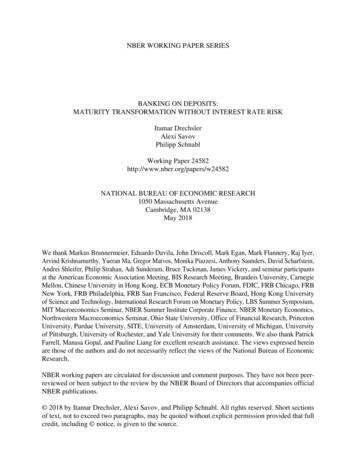
Transcription
NBER WORKING PAPER SERIESDIGITAL DISPERSION: AN INDUSTRIAL AND GEOGRAPHICCENSUS OF COMMERCIAL INTERNET USEChris FormanAvi GoldfarbShane GreensteinWorking Paper 9287http://www.nber.org/papers/w9287NATIONAL BUREAU OF ECONOMIC RESEARCH1050 Massachusetts AvenueCambridge, MA 02138October 2002We thank Tim Bresnahan, Steve Klepper, Roger Noll, Scott Stern, and Manuel Trajtenberg for comments.We also thank Harte Hanks Market Intelligence for supplying data. We received funding from the KelloggSchool of Management and the GM Strategy Center and seed funding from the National Science Foundationand Bureau of Economic Analysis. All opinions and errors are ours alone. The views expressed herein arethose of the authors and not necessarily those of the National Bureau of Economic Research. 2002 by Chris Forman, Avi Goldfarb and Shane Greenstein. All rights reserved. Short sections of text,not to exceed two paragraphs, may be quoted without explicit permission provided that full credit, including notice, is given to the source.
Digital Dispersion: An Industrial and Geographic Census of Commercial Internet UseChris Forman, Avi Goldfarb and Shane GreensteinNBER Working Paper No. 9287October 2002JEL No. L63, L86, O33ABSTRACTOur study provides the first census of the dispersion of Internet technology to commercialestablishments in the United States. We distinguish between participation, that is, use of the Internetbecause it is necessary for all business (e.g., email and browsing) and enhancement, that is, adoptionof Internet technology to enhance computing processes for competitive advantage (e.g., electroniccommerce).Employing the Harte Hanks Market Intelligence Survey, we examine adoption of the Internetat 86,879 commercial establishments with 100 or more employees at the end of 2000. Using routinestatistical methods, we focus on answering questions about economy-wide outcomes: Whichindustries had the highest and lowest rates of participation and enhancement? Which cities, statesand industries had a typical experience and which did not?We arrive at three conclusions. First, participation and enhancement display contrastingpatterns of dispersion. In a majority of industries participation has approached saturation levels,while enhancement occurs at lower rates and with dispersion reflecting long standing industrialdifferences in use of computing. Second, the creation and use of the Internet does not eliminate theimportance of geography. Leading areas are widespread, whereas laggards are more common insmaller urban areas and some rural areas. However, the distribution of industries across geographicregions explains much of the difference in rates of adoption of the Internet in different areas. Third,commercial Internet use is quite dispersed, more so than previous studies show.Chris FormanCarnegie Mellon University5000 Forbes Ave.Pittsburgh, PA 15213Shane GreensteinNorthwestern University2001 Sheridan RoadEvanston, IL 60208and NBERgreenstein@kellogg.northwestern.eduAvi GoldfarbUniversity of Toronto105 St George StreetToronto, ON, Canada, M5S 3E6
Digital DispersionForman, Goldfarb, and Greenstein1. IntroductionAdvances in frontier technology are only the first step in the creation of economic progress.The next step involves use by economic agents. Adoption by users typically needs time, inventionand resources before economic welfare gains are realized. This principle applies with particularsaliency to the Internet, a malleable technology whose form is not fixed across location. To createvalue, the Internet must be embedded in investments at firms and households that employ a suite ofcommunication technologies, TCP/IP protocols and standards for networking between computers.Often organizational processes also must change.The dispersion of Internet use to commercial users is a central concern for economic policy.As a general purpose technology (GPT) (Bresnahan and Trajtenberg 1995), the Internet will have agreater impact if and when it diffuses widely to commercial firms. This is particularly so becausecommercial firms do the vast majority of investment in Internet infrastructure, and at a scale ofinvestment reaching tens of billions of dollars. Concerns about dispersion are difficult to address,however. Measuring dispersion requires a census of commercial Internet use, which, in turn, requiresextensive data and an appropriate framework. This has not been done by any prior research. Thisstudy fills this gap.We construct a census on adoption, the most common yardstick for measuring a newtechnology's use (Rogers, 1995). How widely dispersed is Internet technology across locations andindustries? Which regions and industries adopt often and which do not? How does this measurementof dispersion compare with other ways of measuring the spread of the Internet?Three themes shape our approach to answering these questions. First, our approach isconsistent with standard ruminations about the strategic advantages affiliated with adoption ofInternet technology. For example, some investments in Internet technology are regarded as “tablestakes”—they are required for companies to be a player in a market—whereas other investments are1
Digital DispersionForman, Goldfarb, and Greensteinregarded as the basis of competitive advantage (Porter 2000). Second, our framework extendsprinciples of "universal service" to Internet technology (Compaine, 2001, Noll et. al., 2001). Third,since there is no preset pattern for the adoption of GPTs, we seek to understand document differencesin adoption between industries and locations.We propose to analyze the dispersion of use of the Internet in two distinct layers. In onelayer—hereafter termed participation—investment in and adoption of Internet technology enablesparticipation in the Internet network. Participation is affiliated with basic communications, such asemail use, browsing and passive document sharing. It also represents our measure of “tables stakes,”namely, the basic Internet investment required to do business. In the second layer—hereafter termedenhancement—investment in and adoption of Internet technology enhances business processes.Enhancement uses Internet technologies to change existing internal operations or to implement newservices. It represents our measure of investment aimed at competitive advantage.Our analysis covers all medium and large commercial users, approximately two-thirds of theworkforce. We use a private survey of 86,879 establishments with over 100 employees. The surveyis updated to the end of 2000. Harte Hanks Market Intelligence, a commercial market research firmthat tracks use of Internet technology in business, undertook the survey. We use the County BusinessPatterns data from the Census and routine statistical methods to generalize our results to the entirepopulation of medium to large establishments in the United States.We develop three major conclusions: First, we conclude participation and enhancementdisplay contrasting patterns of adoption and dispersion. Overall, we find an average rate of adoptionin excess of 88%; participation is near saturation in a majority of industries. By any historicalmeasure, such extensive adoption is quite remarkable for such a young technology. In contrast,though enhancement is widespread across industries and locations, the rate is much lower than that2
Digital DispersionForman, Goldfarb, and Greensteinfound for participation. Such investment occurs at approximately 12.6% of establishments. By thelong-standing norms for different industries, this pattern of investment is not surprising.The finding for participation suggests that Internet adoption costs are low and the benefits arehigh. The finding for enhancement suggests that Internet adoption costs are high and benefits morevariable. We argue that both perceptions are correct, even though they appear to contradict each otheron the surface. Each perception reflects the distinct economic costs and benefits from investmentactivities affiliated either participation or enhancement. More to the point, the productivity associatedwith investments in participation and enhancement are distinct, meriting separate analyses.Second, we show that Internet technologies displayed geographic usage patterns common toother communication technology, however we argue different reasons from other authors.Specifically, there is evidence consistent with a mild geographic digital divide in both participationand enhancement. Although participation is high, the average establishment in a small metropolitanstatistical area (MSA) or rural area is about 10% to 15% less likely to participate than one in thelargest MSAs. Also, establishments in MSAs with over one million people are one and a half timesas likely to use the Internet for enhancement than are establishments in MSAs with less than 250,000people.Why do some regions lead and others lag? We offer an explanation that differs sharply withthe literature on digital divide. We conclude that the (pre-existing) distribution of industries acrossgeographic locations explains much of the differences in rates in enhancement. This is not the entireexplanation, but it is the most self-evident one. Moreover, because leadership in enhancement is quitedispersed across industries, it is also quite dispersed across locations. Hence, we question theprevailing opinion that the dispersion of the Internet sharply benefited a small number of regions.Consequently, we argue that regional growth policies have focused on correcting lack of participationor concentration of technologies in a few locations, but should additionally focus on understanding3
Digital DispersionForman, Goldfarb, and Greensteinhow regional growth policies can broaden the foothold that enhancement has across the majority ofregions.Third, existing studies fail to document the dispersion of use by commercial establishments.We establish this by comparing our data with other measures. We find that the geographic dispersionof commercial Internet use is positively related to the dispersion in household and farm use, asdocumented in previous research, but the relationship is not strong. Hence, we conclude that previousstudies provide a misleading picture of dispersion.1More broadly, we also conclude that existing surveys of commercial firms provide anincomplete picture of adoption and its dispersion. For example, the US Census has undertaken a largeone-time survey of manufacturing plants.2 Yet, manufacturing only comprises a third of UScommercial establishments. Our study discusses the sense in which manufacturing does and does notrepresent the experience in other industries. In addition, several private surveys have analyzed theproductivity benefits of Internet technologies at commercial firms, analyzing factors other thandispersion.3 In contrast, our approach aims for unprecedented geographic or industrial breadth, butdoing so requires focusing on only for a few narrowly defined questions.2. BackgroundOur framework builds on microstudies of Internet investment in commercial establishmentsand organizations.4 It is motivated by the user-oriented emphasis in the literature on GPTs .51To be sure, there has been much progress. For information about PC use, see e.g., National TelecommunicationsInformation Administration (2001), Census (2001), and Goolsbee amd Klenow (1999); and for the beginnings inmeasuring electronic commerce see, e.g., Fraumeni(2001), Landefeld and Fraumeni (2001), Mesenbourg (2001), orWhinston et al. (2001). We discuss this further below.2See Atrostic, Gates, and Jarmin (2000), Mesenbourg (2001), and Atrostic and Gates (2001), as well as the Census(2002).3Also, the samples are often too small to study dispersion. See Varian et al. (2001), Whinston et al. (2001), Forman(2002), and Kraemer, Dedrick and Dunkle (2002).4See e.g., Forman (2002), Jones, Kato and Pliskin (2002), Gertner and Stillman (2001), Carlton and Chevalier (2001),Tan and Teo (1998).5See e.g., Bresnahan and Trajtenberg (1995), Bresnahan and Greenstein (2001), Helpman (1998).4
Digital DispersionForman, Goldfarb, and Greenstein2.1 General Purpose Technologies and the Commercialization of the InternetThe diffusion of the Internet can be viewed in the context of observations about technologicalconvergence (Ames and Rosenberg 1984), which is the increasing use of a small number oftechnological functions for many different purposes. Bresnahan and Trajtenberg (1995) develop thisfurther in their discussion of GPTs, which they define as capabilities whose adaptation raises themarginal returns to inventive activity in a wide variety of circumstances. GPTs involve high fixedcosts in invention and low marginal costs in reproduction. A GPT is adapted for any new use, and thisadaptation takes time, additional expense and further invention. Following the literature, we labelthese as co-invention expenses. Studies have found that co-invention influences computing andInternet technology investments by business users (Bresnahan and Greenstein 1997, Forman 2002).Almost by definition, GPTs have a big impact if and when they diffuse widely, that is, if theyraise the marginal productivity of a disparate set of activities in the economy. As a practical matter,"disparate" means a great number of applications and industries, performed in a great number oflocations. What stands in the way of achieving wide and disparate diffusion? Barriers arise as a resultof users facing different economic circumstances, such as differences in local output marketconditions, quality of local infrastructure, labor market talent levels, quality of firm assets orcompetitive conditions in output markets. Simply put, these barriers are different co-inventionexpenses.There is no preset pattern for the dispersion of GPTs. They can diffuse in layers or waves(e.g., Lipsey, Becker and Carlaw 1998). Below we argue that analysis of the dispersion of the Internetto commercial business requires analysis of distinct layers. We hypothesize that the co-inventioncosts of certain types of Internet investment were low, whereas other bottlenecks persistentlyproduced high co-invention costs. When costs for some activities were low, adoption of these aspectsof Internet technology became required to be in business. When the costs were higher and the benefits5
Digital DispersionForman, Goldfarb, and Greensteinvariable for other aspects, firms were more circumspect, investing only when it provided competitiveadvantage.Consequently, we ignore differences across applications and intensities of use within anestablishment. We focus on two layers that vary across location and industry. We label these layers asparticipation and enhancement.The first layer, participation, is a key policy variable. As noted, it represents the basicrequirements for being at the table for medium and large businesses. By 2000, participation wasregarded as a routine matter.6 Its emphasis also arises in many studies of ubiquitous communicationsnetworks. A ubiquitous network is one in which every potential participant is, in fact, an actualparticipant. Concerns about ubiquity emerge in policy debates about applying principles of "universalservice" to new technologies (Cherry, Hammond and Wildman 1999, Compaine 2001, Noll et al,2001). For our purposes, we recognize that many different policies for ubiquity target geographicvariance in adoption (e.g., reducing urban/rural differences).The second layer, enhancement, is another key policy variable because its use is linked to theproductive advance of firms and the economic growth of the regions in which these firms reside. Itusually arrives as part of other intermediate goods, such as software, computing or networkingequipment. Implementation of enhancement was anything but routine. Enhancement includedtechnical challenges beyond the Internet’s core technologies, such as security, privacy, and dynamiccommunication between browsers and servers. Organizational procedures usually also changed.7Benefits accrue to the business organization employing enhancement through the addition ofcompetitive advantage, but the co-invention costs and delays vary widely.6Examples of participation include browsing and posting text-based web pages, advertising on the World Wide Web(WWW), WWW browsing, and a basic intranet.6
Digital DispersionForman, Goldfarb, and Greenstein2.2 A framework for measuring regional and industrial dispersionParticipation represents a measure of “table stakes,” while enhancement represents a measureof investment for competitive advantage.8 Both layers of activity are important for economic advance,but each has distinct effects on regional and industrial growth. We do not necessarily presume that thetwo are closely related, but intend to measure the correlation between them.We will measure the dispersion of Internet technology across locations and industries. Sincethere is no single way to measure dispersion, we will modify our analysis to the data available. Ourfirst research strategy involves identifying leaders and laggards, and comparing their features. Giventhat this study is the first to examine such data, our primary goal is to document and rank. Because weare interested in measuring the dispersion of Internet use across industry and location rather than itsevolution across time, an analysis of the cross-section data is sufficient for our purposes.3. Data and MethodThe data we use for this study come from the Harte Hanks Market Intelligence CI Technologydatabase (hereafter CI database). The CI database contains establishment-level data on (1)establishment characteristics, such as number of employees, industry and location; (2) use oftechnology hardware and software, such as computers, networking equipment, printers and otheroffice equipment; and (3) use of Internet applications and other networking services. Harte HanksMarket Intelligence (hereafter HH) collects this information to resell as a tool for the marketing7See for example, Malone, Yates, and Benjamin (1987), Hubbard (2000), Hitt and Brynjolfsson (1997), or Bresnahan,Brynjolfsson, and Hitt (2002).8Careful readers will notice that this varies from the definitions employed by Porter (2000). This is due to a difference inresearch goals. Throughout his article, Porter discusses the determinants of, and shifting boundaries between, investmentsthat provided table stakes and those that complement a firm's strategy and enhance competitive advantage. He argues thatthese levels vary by industry and differ from firm to firm. This is the proper variance to emphasize when advisingmanagers about their firm's strategic investment. However, when measuring this variance for purposes of formulatingpolicy advice it is useful to shift focus. Our measurement goals require both a standardized definition (of something ofinterest for policy, but consistent with the spirit of strategy research) and a consistent application across industries andlocations.7
Digital DispersionForman, Goldfarb, and Greensteindivisions at technology companies. Interview teams survey establishments throughout the calendaryear; our sample contains the most current information as of December 2000.9HH tracks over 300,000 establishments in the United States. Since we focus on commercialInternet use, we exclude government establishments, military establishments and nonprofitestablishments, mostly in higher education.10 Our sample contains all commercial establishmentsfrom the CI database that contain over 100 employees, 115,671 establishments in all; 11 and HHprovides one observation per establishment. We will use 86,879 of the observations with completedata generated between June 1998 and December 2000. We adopt a strategy of utilizing as manyobservations as possible, because we need many observations for thinly populated areas.12 Thisnecessitates routine adjustments of the data for the timing and type of the survey given by HH. Seethe appendix.3.1. Data Description and Sample ConstructionIn Table 1, we show a few features of our final sample. We sample corporate America well.The largest establishment in our sample has 56,000 employees.13 Forty-five percent ofestablishments are part of a multi-establishment firm. Nine hundred twenty-one of the Fortune 1000are represented. However, we also have broad representation among smaller firms. The medianestablishment in our sample has 174 employees.9Using rotating teams of interviewers, HH collects data for the CI database. While HH selects some establishments for adetailed interview on technology usage, others receive a shorter interview that highlights the most important uses of IT.10Noncommercial establishments have distinct patterns of Internet use from commercial establishments. First,participation is a given at virtually every educational establishment in the US. Second, military establishments often use atechnically separate network from that used by commercial establishments. Third, the impact of the use by theseestablishments, while important for the provision of many public goods, is distinct from that by commercial firms.11Previous studies (Charles, Ives, and Leduc 2002; Census 2002) have shown that Internet participation varies withbusiness size, and that very small establishments rarely make Internet investments for enhancement. Thus, our samplingmethodology enables us to track the relevant margin in investments for enhancement, while our participation estimatesmay overstate participation relative to the population of all business establishments.12If we were only interested in the features of the most populated regions of the country, then we could easily rely solelyon the most recent data from the latter half of 2000, about 40% of the data. However, using only this data would result invery small number of observations for most regions with under one million in population.13This is the Walt Disney World Resort.8
Digital DispersionForman, Goldfarb, and GreensteinEstablishments vary in their use of Internet technology. The number of PCs per employeevaries from 0 to 26.92.14 The average firm has 0.37 PCs per employee, and the standard deviation islarge (0.53). Fifty-seven percent of establishments have a LAN, and 39% have a server, mainframeor some other kind of non-PC computing hardware. In all, we sample a wide range of establishments.In Table 2 our final sample is compared to the County Business Patterns data from the 1999Census. The first row shows that our sample contains slightly less than half of all establishmentswith over 100 employees in the United States. While this is only 1.3% of all establishments, our datarepresents roughly one-third of all employment. The table shows that in terms of company size,region, industry and urban versus rural location the numbers are generally close. We slightly underrepresent MSAs (a proxy for urban counties) and Consolidated Metropolitan Statistical Areas, orCMSAs, (a proxy for large cities). Most industries are also represented in proportion to their actualdistribution. The regional representation is close, with a slight under-sample of the Northeast andover-sample of the Mid-west. Our sample also includes a disproportionate number of (1) companiesin rural areas and (2) large establishments (over 500 employees).We compared the number of firms in our database to the number of firms in the Census. Wecalculated the total number of firms with more than 50 employees in the Census Bureau’s 1999County Business Patterns data and the number of firms in our database for each two-digit NAICScode in each location.15 We then calculated the total number in each location. This provides the basisfor our weighting. The weight for a given NAICS in a given location isTotal # of census establishments in location NAICSTotal # of establishments in our data in location Total # of census establishments in locationTotal # of establishments in our data in location NAICS14For example, the Allen Memorial nursing home in Mobile, AL has no PCs. A Worcester research center for theUniversity of Massachusetts has 26.92 PCs per employee.15We used 50 employees because many of our HH employment data comes later than 1999. Consequently, firms mayhave grown. Using 50 employees instead of 100 gives a comprehensive measure of the number of medium and largefirms without the number of firms in our data ever being larger than the number in the census. We used two-digit NAICSinstead of three digit NAICS for sample size reasons.9
Digital DispersionForman, Goldfarb, and GreensteinIn other words, the weights are the proportion of establishments in a location that are a given NAICScode, divided by the proportion of times it is in our database. This means that if our data undersamples a given two-digit NAICS at a location, then each observation in that NAICS-location isgiven more importance. The weights for industry are calculated similarly, but instead of eachlocation being split into NAICS, each NAICS is split by state.16Using two survey forms, HH surveyed establishments at different times. To adjust fordifferences in survey time and type, we econometrically estimate the relationship between anestablishment’s decision to participate or enhance as a function of its industry, location, timing ofsurvey and form of survey. We then calculate predicted probabilities of adoption for eachestablishment as if it were surveyed in the second half of 2000 and were given the long survey. Oncewe weight by the true frequency of establishments in the population, we have information aboutestablishments related to two-thirds of the US workforce. The more observations we have for a givenregion or industry the more statistical confidence we have in the estimate. See the appendix forfurther detail.3.2. Definitions of behaviorIdentifying participation was simple compared to identifying enhancement. We identifyparticipation as behavior in which an establishment has basic Internet access or has made any type offrontier investment. In contrast, for enhancement, an establishment must have made the type ofinvestment commonly described in books on electronic commerce. We identify enhancement fromsubstantial investments in electronic commerce or “e-business” applications. We look for16We also adjusted our data because of the establishment definition: HH’s definition of an establishment does not alwaysmatch the Census. In particular, what HH lists as two different establishments may only be one establishment under theCensus definition. Where this occurred, we aligned the HH data with the definition listed in the Census. If the same firmwas observed to operate in the same five-digit zip code with the same six-digit NAICS code, it is likely that the Censuswould consider it one establishment. There were 2440 establishments in our data that fit the above criteria. If twoestablishments were to be combined, then the weights were multiplied by one-half. Similarly, if there were nestablishments, the weights would be multiplied by 1/n. The number of firms in each location would also take thesechanges into account.10
Digital DispersionForman, Goldfarb, and Greensteincommitment to two or more of the following projects: Internet-based enterprise resource planning orTCP/IP-based applications in customer service, education, extranet, publications, purchasing ortechnical support. Again, see the appendix.In Table 3 we show the results of these definitions. Participation by establishments within thesample is at 80.7%. The sample under-represents adopters, and our estimate of economy-widedistribution (using the true distribution of establishments from the Census) is 88.6%. We list the samenumber for those engaging in enhancement. It is 11.2% in our sample (see Unweighted Average inTable 3) and 12.6% in the true distribution (see Weighted Average in Table 3). We also can estimatethe rate of adoption by “experimenters,” that is, those establishments with some indication of use, butnot much. As one would expect for a technology still in the midst of diffusion, the proportion forexperimenters (combined with enhancement) is considerably higher than for enhancement alone,reaching 18.1% for the unweighted average and 23.2% for the weighted average. We have exploredthis latter definition and found that it tracks the enhancement definition we use below, so it providesno additional insight about the dispersion of use. We do not analyze it further.4. Leading industriesIn Tables 4a and 4b we list the estimates for participation and enhancement organized by twodigit NAICS industry; we list industries in the order of highest to lowest adoption rates. We firstshow the results for all two-digit NAICS industries in the left half columns, and then break them intotheir three-digit NAICS industries in the right half columns. We identify leading and laggardindustries. We also list the standard errors and number of observations.4.1. ParticipationOur first finding is quite apparent in Table 4a – participation is high in every industry,reaching over 92% -- near saturation -- in a majority of them. Of course, this is not a surprise after11
Digital DispersionForman, Goldfarb, and GreensteinTable 3, since the average rate of participation was 88%. The striking feature in Table 4a is the skewof these results. Establishments in all but four two-digit NAICS industries are at 90% or higher. Withrare exception, the Internet reaches almost everywhere.17 Participation clearly represents a low cost“table stakes” .We conclude that participation is virtually ubiquitous in all establishments excepting – atworst – a few industries. This dispersion is consistent with the popular perception that (1) adoptioncosts were low, (2) the Internet was available almost everywhere, (3) virtually any businessexperienced some benefit from adoption, (4) this diffusion saturated potential adopters sometimebefore the decline in Internet technology spending in 2001 and (5
Digital Dispersion: An Industrial and Geographic Census of Commercial Internet Use Chris Forman, Avi Goldfarb and Shane Greenstein NBER Working Paper No. 9287 October 2002 JEL No. L63, L86, O33 ABSTRACT Our study provides the first census of the dispersion of Internet technology to commercial establishments in the United States.
